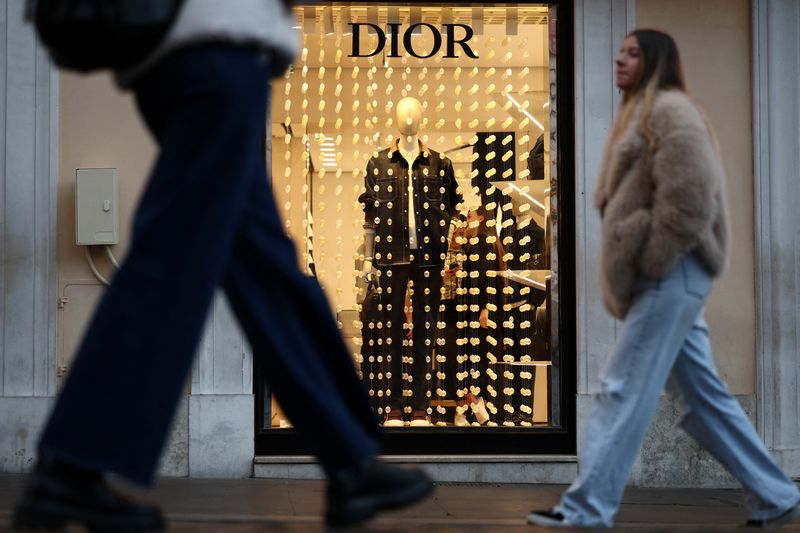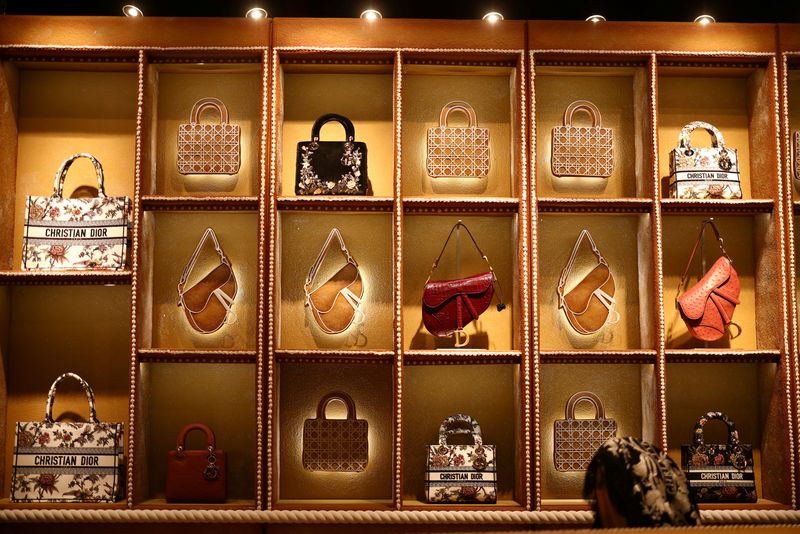By Mimosa Spencer
PARIS (Reuters) - Confronting a broad decline in demand for their usual fare, including $3,000-and-up handbags and $4,000-and-up cashmere jackets, major marketers of designer and luxury merchandise are broadening their product lines to emphasize scarves, belts, wallets and home goods priced at $500 and under.
The companies' renewed focus on more affordable products is meant to appeal to middle-class aspirational customers who are more price sensitive, although the strategy may dent companies' typically fat profit margins.
After more than two years of sharp price hikes -- with Chanel, Prada (OTC:PRDSY) and LVMH's Dior raising handbag prices by over 50% in France in 2023 compared to 2020, according to the Wall Street analysts at Bernstein -- luxury labels are finding themselves at risk of alienating the middle class.
U.S. spending on merchandise from top luxury brands fell 6% year on year in November, according to credit-card data from Citi, setting a dour tone to the early holiday shopping season for LVMH, Kering (EPA:PRTP) and other global purveyors of designer goods.
LOGOS FOR UNDER $500
Kering label Gucci's decor and lifestyle gifts this season include a $440 pet leash and a box of sticky notes covered with the brand logo, priced at $200.
Louis Vuitton, which belongs to LVMH, offers a $360 card holder and a $395 canvas and metal Monogram Double Spin bracelet for $395 on the gifts section of its e-commerce site.
Burberry (LON:BRBY) plans to change its store layout to emphasise "scarf bars" to drive sales of its cashmere scarves priced from $450 to $1,050.
And Kering and Cartier's Richemont (SIX:CFR) seek to bring their perfumes and cosmetics lines back in-house while LVMH has been developing cafes and entertainment, said Jonathan Siboni, CEO of Luxurynsight.
DEMAND FRAGILE AFTER US ELECTION
Following the U.S. presidential election on Nov. 5, "luxury demand appears fragile, particularly with the aspirational clientele," analysts at Citi said, highlighting weak household employment in November following tepid U.S. hiring.
The absence of this consumer is reflected in a decline in global luxury shoppers by 60 million to 355 million, analysts at RBC said. They cite pressures from inflation and growing interest in spending on experiences rather than products as key reasons for the drop-off.
Global sales of luxury personal goods like clothing, accessories and beauty products, are expected to be flat at constant exchange rates during the holiday season, according to consulting firm Bain.
Bain earlier forecast that global sales of personal luxury goods would drop 2% this year, one of the weakest on record, with a shrinking client base – especially the so-called aspirational shoppers, who are more price sensitive.
CHINA DEMAND DAMPENED
Appetite for high-end goods in China, one of the luxury goods industry's biggest markets and main source of growth in recent years, has been dampened by a property crisis and low youth unemployment, with analysts at JPMorgan predicting a "bumpy" outlook for the sector after a tough 2024, as ongoing macro challenges in China continue to weigh.
In this context, luxury spenders are particularly selective. They do not want to buy things perceived as "lower quality or old styles," said Caroline Reyl, head of premium brands at Pictet Asset Management.
Instead, brands can gain attention through marketing campaigns as well as expanded product categories, along with the shift toward more affordable product categories.
“Still very high quality, but just cheaper in terms of price points,” Reyl added.
Siboni, who combines information pulled from brand websites as well as the companies themselves, has seen an average increase of 8% of small leather goods such as wallets in proportion to full-size handbags compared to a year ago.
In November, the average price of small leather goods at LVMH's Dior brand was down 21% year on year, according to Luxurynsight data. Meanwhile its Louis Vuitton label has increased the ratio of products in its small leather goods selection priced under 500 euros by 9% compared to the same period last year.
PROFIT MARGIN EROSION LIKELY
The emphasis on lower-priced products, while necessary to preserve relevance at a time when middle-class and even wealthy shoppers are balking at high-priced merchandise, is likely to erode the profit margins of players such as LVMH and Balenciaga-parent Kering, which are already facing pressure due to slowing sales.
"What we are trying to do is to stretch the price range," Andrea Guerra, chief executive officer of industry outperformer Prada, told analysts at the end of October.
Meanwhile, Burberry's new CEO Joshua Schulman, introducing his turnaround plan for the British luxury label, stressed the broadening of the assortment of entry-level priced products, noting that pricing was pushed "too high across the board."

Industry bellwether LVMH, however, cautioned against the risk of veering too far off brand, which could damage a label’s exclusive aura. Chief Finance Officer Jean-Jacques Guiony said the group would steer away from introducing a new range of "very affordable product."
“I think it would be a mistake,” he told analysts in October, stressing the importance of not entirely changing offerings with a “very short-term view.”
